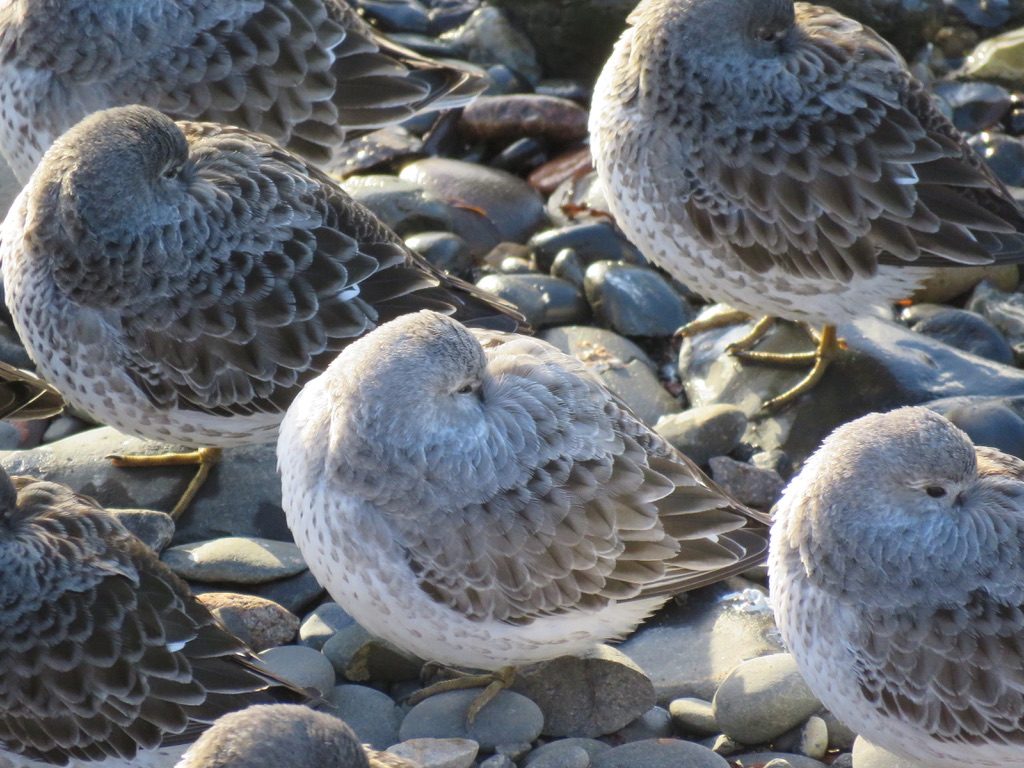Gary Lyon, Kachemak Bay Birder, describes our Bird of the Month for May – the Townsend’s Warbler. The Townsend’s Warbler is the only one of eight warblers found in Alaska. Listen to the Bird Rhythms audio to learn more about the Townsend’s Warbler, and what the other seven warblers are found in Alaska during the breeding season.
Author: Michelle Michaud
June 2019 Bird of the Month – Merlin
Merlin
(Falco columbarius)
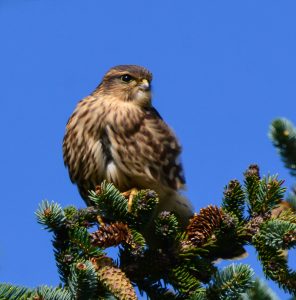
General Information: The Merlin is “pigeon” size, which is why it might also be known as the “pigeon hawk.” This small raptor, known for its speed, is a member of the falcon (Falconidae) family.
North America Range
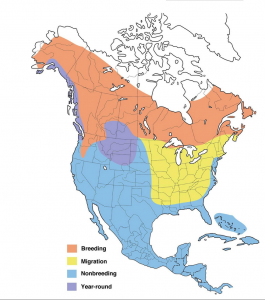
Source: https://www.allaboutbirds.org/guide/Merlin/maps-range
Bird Biology:
Characteristics: This small falcon has a large head, stocky body, sharply pointed wings, wings are sharply pointed. Males are slaty-gray to dark gray, while female and immature birds are browner. The chest is heavily streaked, the underwings are dark. The tail sports narrow white bands. The falcon’s face lacks the “mustache” strip or malar depicted on American Kestrels or Peregrine Falcons. Some think their expression is mean looking.
These birds are between 9.4 and 11.8 inches in length, weigh in between 5.6 and 8.5 ounces, and have a wingspan of 20.9 to 26.8 inches. Females are larger than the males. Size wise, they are between a robin and a crow.
The Merlin is generally solitary during the non-breeding season. This bird is stealthy and does not hover, like an American Kestrel. Its flight is fast (typically 30+ miles per hour) and direct, seeming to appear out of nowhere, flying with rapid wing-beats, unlike the Sharp-shinned Hawk which has a flap, flap, glide motion.
Preferred Habitat: Open and semi-open habitat – prairies; open or broken coniferous forests; rivers and bogs in forest, tundra, alpine tundra; coastal areas; and islands on large lakes. In urbanized areas, may be found along tree-lined streets, cemeteries, and parks. You may encounter the Merlin looking for a meal at your bird feeder – the meal being an unsuspecting bird.
In the breeding season, the Merlin breeds in the forest – sparse woodlands edges, mountainous areas, or open plains/prairies with scattered trees.
Wintering habitat does not differ, although the Merlin may be frequently found in coastal areas with an abundance of shorebirds to prey upon or in open prairies with an abundance of longspurs and larks.
Breeding Season: Begins early to mid May, ending early July.
The Merlin performs flight displays to attract a female. These displays include strong bursts of level flight, while rocking side to side; broad U-shaped dives; and slow, fluttering flights in a circle or figure-eight when near a perched mate. The male will make a slow landing keeping its legs outstretched, head bowed, and tail fanned. And what female can resist and male who brings her food?
Nest: The Merlin utilizes old tree nests of other birds (e.g., corvids and hawks) . Sometimes they may use an open tree cavity, cliff-ledges, rocky hillsides, and even find a suitable nesting spot on the ground. When nesting in a tree, the nest is generally 15-35 feet above the ground, but may be as high up as 60 feet. If on the ground, the bird will line the nest with plant material pulled in while the bird is on the nest. They rarely reuse the same nest. The Merlin is highly territorial during the nesting season and will chase off other Merlins.
Eggs and Incubation: Lays 5-6 eggs. The eggs are laid at two-day intervals. Single brood. The female begins incubation of the egg, before completing the clutch (i.e., before all the eggs are laid). The male brings food to the female during incubation. Incubation last 28-32 days.
Nestling Period: The nestlings are born altricial (naked, but downy). The young are closely brooded by the female, with the male bringing prey, but not feeding the young. Later both parents hunt to feed the growing chicks.
Fledging: The young have their feathers fully developed by 18 days, but do not fly until 25-30 days after hatching. The youngsters remain near and under the care of their parents for another six weeks before striking out on their own.
Food Preferences: Primarily small birds, but also insects and small mammals.
Feeding Methodology: The Merlin is a perch-hunting raptor, however you will rarely, if ever, see it perched on a wire. The Merlin is a master of stealth, its attack is fast and direct. This bird likes to hunt flocking species. It will consume its insect prey on the wing (in-flight) and with non-insect prey, it will find a perch in order to pluck and consume. Young Merlin will target dragonflies – maybe they like the challenge? You may find the Merlin perched for long periods of time while it scans for unsuspecting prey.
During Homer’s Shorebird Festival in May, you can generally find a Merlin on the Homer Spit in search of shorebirds such as Sandpipers and Dunlin. The Merlin attacks at high speed, coming in horizontally or from below the horizon. They generally chase their prey until the prey tires.
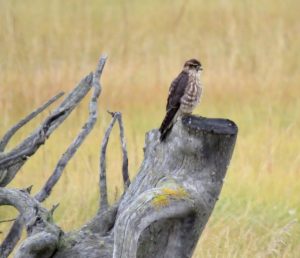
Migration: The Merlin is a long-distance migrant except for the dark-morph Merlin that resides in the Pacific Northwest, which live their year-round or migrate short distances following a food source. The northern prairie Merlin generally migrates to the southern and central U.S. and northern Mexico. Our Alaskan Merlin (the taiga form) migrates to the coastal and southern U.S., and may even travel as far south as Ecuador.
Spring migration is mid-February to mid-May. Winter migration is late July to mid-November, peaking in mid-September to late-October.
Vocalizations:
Call: Rapid shrill or chatter – “keh, keh, Keh, Keh, keh, keh
Fun Facts:
- This bird was formerly known as the “pigeon” hawk.
- Also known as the “little blue corporal” or “bullet hawk”
Conservation Status: The Merlin suffered widespread declines in the 1960s due to pesticide contamination. However, with the removal of pesticides such as DDT from use in the United States, the Merlin population is now considered stable.
The International Union of Conservation of Nature has listed the Merlin as a species of Least Concern, with an estimated worldwide population between 0.5 million and 2.0 million.
The Merlin is not on the Alaska Audubon’s “Alaska Watchlist” for 2017. The National Audubon Society considers the Merlin to be climate endangered.
Threats: While the species population is currently stable, threats to the species include habitat loss from agriculture (farming and ranching), threats from energy production (wind turbines, fracking), transportation (utility and service lines, cell towers), human disturbance (recreational activities), pollution (ag and forestry effluents), invasive species, and climate change.
Similar Species in Alaska: Sharp-shinned Hawk and American Kestrel
Sources of Information:
Audubon, Guide to Birds of North American. Downloaded on May 16, 2019 at: https://www.audubon.org/field-guide/bird/merlin
Baicich, Paul J. and Harrison, Colin J.O. 1997. Nests, Eggs, and Nestlings of North American Birds, 2nd Edition. Princeton Field Guides
BirdLife International 2016. Falco columbarius. The IUCN Red List of Threatened Species 2016: e.T22696453A93562971. http://dx.doi.org/10.2305/IUCN.UK.2016-3.RLTS.T22696453A93562971.en. Downloaded on 16 May 2019.
Cornell Lab of Ornithology. All About Birds. 2017. Downloaded on 16 May 2019 at: https://www.allaboutbirds.org/guide/Merlin/id
Dunne, Pete. 2006. Pete Dunne’s Essential Field Guide Companion: Comprehensive Resource for Identifying North American Birds. Houghton Mifflin Company.
National Audubon Society. Audubon: Guide to North America Birds. Downloaded on
Todd, Frank S. 1994. 10,001 Titillating Tidbits of Avian Trivia. Ibis Publishing Company.
Warnock, N. 2017. The Alaska WatchList 2017. Audubon Alaska, Anchorage, AK 99501.
Bird Rhythms – April 2019
Kachemak Bay Birder, Dale Chorman talks about the more often heard, than seen bird – the Varied Thrush. This bird’s call is unforgettable and is generally one of the first birds heard in the spring.
Have you ever seen a murmuration? This is a coordinated flocking mechanism used by birds where all they take off at once and fly in waves through the air. Why the birds perform this behavior is not readily known. Is it due to avoidance of a predator, like a Merlin or Peregrine Falcon? In early May when the shorebirds return to Homer, they perform murmurations, sometimes so often you wonder when they actually feed.
May 2019 Bird of the Month
Townsend’s Warbler
(Setophaga townsendi)
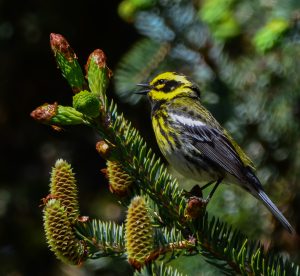
General Information
The Townsend’s Warbler is a small, colorful, black, white, and yellow songbird found in and around Homer during its breeding season. This species is member of the wood warblers in the family Parulidae, genus Setophaga. There are 53 species of wood warblers that occur in North America.
The Townsend’s Warbler is named for John Kirk Townsend, an American naturalist, ornithologist, and collector. Townsend fell ill and died from the effects of powered arsenic used to prepare bird skins. The Townsend’s Solitaire (a Thrush) is also named for him.
Range: The Townsend’s Warbler is a west coast warbler species, breeding in Alaska, Canada, and the Pacific Northwest. This species spends its winter along the west coast from Washington to northern Baja, southern Arizona, trans-Pecos Texas, and Central America.
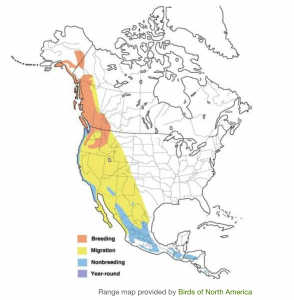
Source: https://www.allaboutbirds.org/guide/Townsends_Warbler/maps-range
Bird Biology:
Characteristics: The Townsend’s Warbler is about 5 inches in length and weighs in at 0.31 oz (8.8 grams). The bird has a bright yellow breast, golden olive cheeks, and gray wings. The male has a black cap, distinct “zorro” mask, black throat, and is streaked black down its sides.
Preferred Habitat: In the breeding season, this warbler can be found in coniferous and mixed deciduous-coniferous forests. In its northern range, it prefers the White Spruce forest. In the winter, these birds also can be found in oaks, madrones, laurels.
A good place to see a Townsend’s Warbler in the Homer area is along the Calvin and Coyle Trail.
Breeding Season: Breeding occurs from late May to early June. The pair form a seasonal pair bond – so a new mate each year. The male is very territorial while on the breeding grounds. This warbler reaches sexual maturity at one-year of age and can begin breeding.
Nest: The nest is a large, compact cup-shaped nest made out of bark, conifer needles, lichens, moss, slender twigs, and dried grasses. The nest is then lined with moss, hair, and fine grasses. The well-concealed nest is built in a conifer tree well out on a horizontal branch. Both sexes are believed to construct the nest.
Eggs and Incubation: Three to seven eggs are laid and incubated for 12 days. Not much is known about incubation, but it is believed that both parents incubate the eggs.
Fledging: The chicks are fed by the female, and possibly by the male. They fledge 8-10 days following hatching.
Food Preferences: Townsend’s Warblers are primarily insectivores – preferring caterpillars, true bugs, and beetles. They may also supplement their diet with a few spiders, seeds, and plant galls.
On the wintering grounds in Mexico, the Townsend’s Warbler feasts on the sugary excretions of scale insects. Yum!!! It loves this food source enough to defend its territories around trees infested with these insects.
Feeding Methodology: Townsend’s Warblers forage in the top 1/3 of a tree by gleening, hawking, and hovering to capture their prey. In the non-breeding season, they will feed in mixed flocks.
Migration: The birds beginning heading north to their breeding grounds (spring migration) in early April through late May, with birds returning to their wintering grounds beginning early August through October. They are often found in mixed flocks during migration.
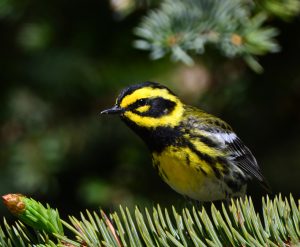
Vocalizations:
Song: “zoo, zoo, zoo zee” or “weezy, weezy, weezy, weeZEE”
Call: Sharp “tsik” or “chip”
Flight Call: Clear “swit”
Threats: The primary threat is loss of habitat, pesticides, and climate change. To see how climate change is predicted to affect the Townsend’s Warbler between 2000 and 2080, go the bottom of the page at: http://www.audubon.org/field-guide/bird/townsends-warbler
Fun Facts:
- Males begin singing prior to leaving their wintering grounds.
- Females may partially construct a nest in one tree, then move all the materials to another tree, finishing the nest there.
Conservation Status: The global population is estimated at around 17 million. The International Union for Conservation of Nature (IUCN) lists the species as “least concern” with a stable population. The National Audubon Society considers the Townsend’s Warbler a “climate threatened” species, although the species is still common and widespread. This species is not on the Alaska Audubon’s Alaska Watchlist.
Common Warbler Species in Alaska: Other warbler species in Alaska includes the Yellow Warbler, Yellow-rumped Warbler, Blackpoll Warbler, Arctic Warbler, Wilson’s Warbler, Orange-crowned Warbler, and the Northern Waterthrush.
Sources of Information
Baicich, Paul J. and Harrison, Colin J.O. 1997. Nests, Eggs, and Nestlings of North American Birds, 2nd Edition. Princeton Field Guides.
BirdLife International 2016. Setophaga townsendi. The IUCN Red List of Threatened Species 2016: e.T22721683A94723311. http://dx.doi.org/10.2305/IUCN.UK.2016-3.RLTS.T22721683A94723311.en. Downloaded on 14 April 2019.
Cornell Lab of Ornithology. All About Birds – Townsend’s Warbler. https://www.allaboutbirds.org/guide/Townsends_Warbler/overview Downloaded on 13 April 2019.
Dunne, Pete. 2006. Pete Dunne’s Essential Field Guide Companion: Comprehensive Resource for Identifying North American Birds. Houghton Mifflin Company.
National Audubon Society. 2018. http://www.audubon.org/field-guide/bird/townsends-warbler. Downloaded on 13 April 2019.
Sibley, David Allen. 2003. The Sibley Field Guide to Birds of Western North America. Andrew Steward Publishing.
Warnock, N. 2017. The Audubon Alaska WatchList 2017. Audubon Alaska, Anchorage, AK 99501
It’s a Great Day to Bird
Bird Rhythms – March 2019
Carol Ford introduces her audience to the Glaucous-winged Gull, Kachemak Bay Birders “Bird of the Month”. She also describes a wandering fall visitor to the Homer area – the Bohemian Waxwing. Learn how this bird got its name and what it likes to eat while visiting the Cosmic Hamlet by the Sea.
Varied Thrush – April Bird of the Month – 2019
Varied Thrush
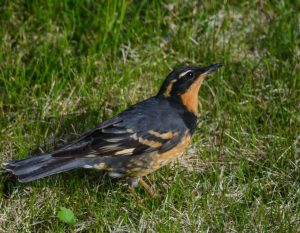
Photo by Robin Edwards
General Information: The Varied Thrush (Ixoreus naevius), a forest loving, secretive bird, is quite common – often heard but not easily observed. It is a member of the Turdidae family (thrushes). The Varied Thrush’s haunting song is generally first heard and welcomed by local Homer area residents in late March or early April as it announces the oncoming, long-awaited, spring season.
Range:
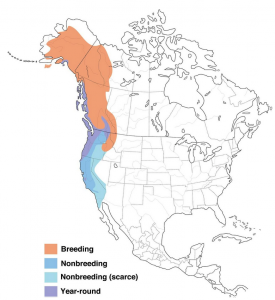
Source: https://www.allaboutbirds.org/guide/Varied_Thrush/maps-range
Bird Biology:
Characteristics: When fortunate to be seen, it is not easy to miss this bird with its distinctive plumage: bold black, blue-gray, and orange. Look for an orange eyebrow, wide black collar, orange underparts, blue-gray back and tail, and orange wing-bars. The female and juvenile are similar in color to the male, but duller and generally lacking the wide black v-shaped collar. This bird is about the same size as the American Robin, but stockier.
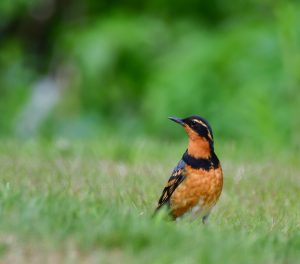
Due to its habitat preference of heavy forest understory, the bird is not readily observed. Be patient. Follow its song and listen for its foraging behavior as it busily scratching the forest floor duff.
Preferred Habitat: This bird’s preferred habitat is the dense, mature, unfragmented moist coniferous forest (fir, hemlock, spruce, with a dense understory). It may also be found in Alder thickets and Aspen groves. In the winter, it is often more visible as it frequents parks, gardens, oak woodlands, ravines, and riparian areas.
Don’t forget to look up, as these birds can sometimes be found singing at tree tops (dead or alive), often perched for extended periods of time as they throw their heads back and vocalize the presence of their territory.
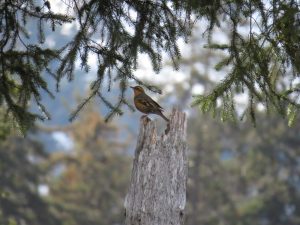
Photo by Michelle Michaud
Breeding Season: The breeding season begins in mid-April for those birds in the southern portion of the bird’s breeding range, and in mid-May for those birds located further north – like our birds in Alaska.
Nest: The male sings to defend its territory, generally active at dawn and dusk. However, the female is believed to choose the nest site. Nests are built utilizing tree branches, with nests located 4-20 feet up, but close to the trunk; generally, in a small conifer.
The female gathers the materials for the open cup nest. The outer layer of the nest is composed of twigs, bark strips, mosses, weeds, and grasses. A layer of rotten wood, moss, mud, or decomposing grasses is then added and allowed to harden the cup. A final nesting layer is composed of fine grasses, dead leaves, and fine moss. The moss is generally draped over the rim and placed on the outside of the nest.
Eggs and Incubation: Generally, three-four eggs, but as many as six and as few as one are laid. The pair may have a double brood. The female alone sits on the eggs for 12 days. Chicks are altricial (eyes closed, downy, and unable to feed themselves). The chicks are tended by both parents.
Fledging: It is estimated the chicks fledge 13-15 days following hatching, however, not a lot is known about child rearing and fledging for Varied Thrush chicks.
Food Preferences: In the breeding season, the Varied Thrush utilizes protein sources such as insects and arthropods found in the leaf litter, including beetles, ants, caterpillars, sowbugs, snails, earthworms, and spiders. In winter, when insects are few, dried fruits, seeds, and nuts make up their diet.
Feeding Methodology: The Varied Thrush forages on the ground, moving dead leaves with a sweeping motion of their bill and then quickly hopping backwards to clear a spot with their feet before checking out their prey. This bird may also forage in low bushes (generally during the winter). This thrush is generally a solitary bird, but in the fall and winter, they may form loose flocks around a good food source. I recently saw seven Varied Thrushes feeding in a state park campground on the northern coast of Oregon.

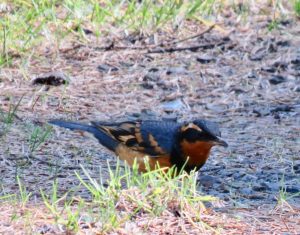
Photos by Michelle Michaud
Migration: Spring migration is mid-March to mid-May, while fall migration is from late August to late November. In the winter, many Alaskan birds migrate to the west coast – south Kenai Peninsula of Alaska to southern California.
Vocalizations:
Song: A haunting sound – “eeeeeeeee” (pause) “errrrrrr”.
Call: Low “churk” or “chup”
To many this bird’s song sounds like fingernails being run down a chalk board.
Threats: Like many birds, loss of forest habitat due to habitat fragmentation and logging is a significant threat. The best conservation strategy is to retain habitat patches of 40-acres or more with habitat connections. Varied Thrushes living around human habitation are subject to window strikes, predation by outdoor cats (domestic and feral), and car collisions.
Fun Facts:
- Varied Thrush populations are cyclical, with fluctuations on a 2-year cycle.
Conservation Status: The Varied Thrush is fairly common. However, populations have declined over 2.5% per year since 1966. The current global breeding population is estimated at 20 million.
The Varied Thrush does not appear on the Audubon Alaska’s “Watchlist”; and is listed as a species of “least” concern by the International Union of Concerned Scientists (IUCN). The IUCN does note the species population is declining.
The National Audubon Society lists the Varied Thrush as a priority bird: climate endangered.
Similar Species in Alaska: American Robin
Sources of Information:
All About Birds. 2017. Cornell Lab of Ornithology. Downloaded on 13 August 2018 at: https://www.allaboutbirds.org/guide/Varied_Thrush/id
Audubon: Guide to North America Birds. Downloaded on 13 August 2018 at: https://www.audubon.org/field-guide/bird/varied-thrush
Baicich, Paul J. and Harrison, Colin J.O. 1997. Nests, Eggs, and Nestlings of North American Birds, 2nd Edition. Princeton Field Guides.
BirdLife International. 2016. Ixoreus naevius. The IUCN Red List of Threatened Species 2016: e.T22708385A94159470. http://dx.doi.org/10.2305/IUCN.UK.2016-3.RLTS.T22708385A94159470.en. Downloaded on 13 August 2018.
Dunne, Pete. 2006. Pete Dunne’s Essential Field Guide Companion: Comprehensive Resource for Identifying North American Birds. Houghton Mifflin Company.
Warnock, N. 2017. The Alaska WatchList 2017. Audubon Alaska, Anchorage, AK 99501. Downloaded on 13 August 2018 at: http://ak.audubon.org/conservation/alaska-watchlist
It’s a Great Day to Bird
Rock Sandpipers: The contrarian shorebird
Kachemak Bay Birder George Matz, in a Point of View article for the Homer News, descsribes the hardy Rock Sandpiper that comes to Homer to spend the winter, whereas most shorebirds head further south.
For the complete article go to: https://www.homernews.com/opinion/point-of-view-rock-sandpipers-the-contrarian-shorebird/
Christmas Bird Count Tally
A total of 71 bird species were observed during the 2018 Homer, Alaska CHRISTMAS BIRD COUNT. This is a new record. Not bad for our little cosmic hamlet by-the-sea.
Check out the article in the Homer News by Michael Armstrong: https://www.homernews.com/opinion/birders-find-a-record-71-species-for-christmas-bird-count/
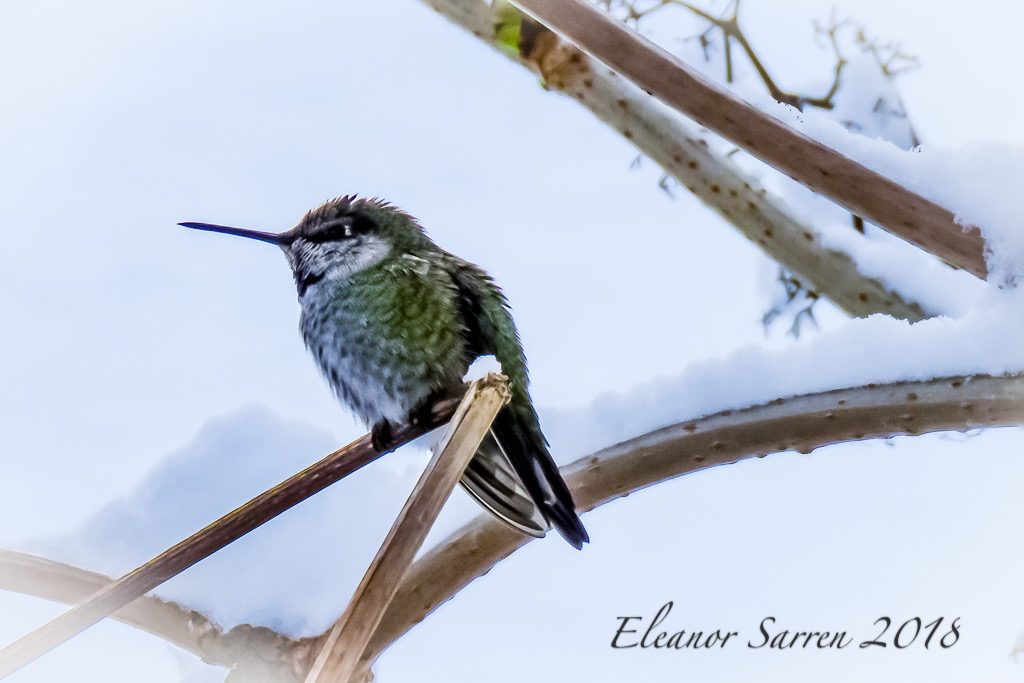
Bird Rhythms – February 2019
Kachemak Bay Birder Carol Harding, highlights the February Bird of the Month – Rock Sandpiper. This hardy bird winters in Homer, and can be found roosting at high tide at the Homer Small Boat Harbor. Carol also describes two different processes found in birds: “irruptive” and “leucistic”. The “irruptive” process, occurs where birds, not readily seen in the Homer area during the winter, appear in great numbers, such as the increase in the number of Red Crossbills this winter and last. A “leucistic” bird is one that has white feathers, whole or in part. These birds are not albinos, as they lack the red eye. Listen to Carol as she explains these fascinating aspects of bird life.
Glaucous-Winged Gull – March 2019 Bird of the Month
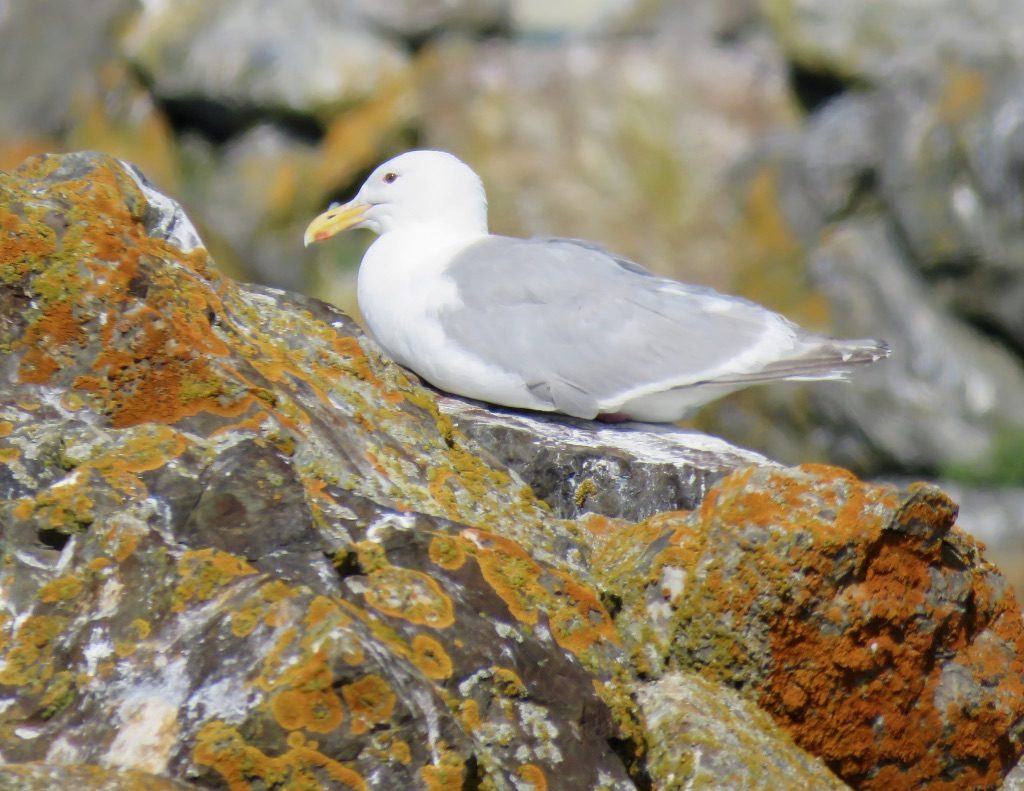
Photo by Michelle Michaud
General Information: The Glaucous-winged Gull (Larus glaucescens) is a common west coast breeder and winter resident found year-round in on the Kenai Peninsula. No sexual dimorphism here – both male and female look alike. They are members of the Order: Charadriiformes (which includes Shorebirds), Family: Laridae (Gulls and Terns)
North America Range
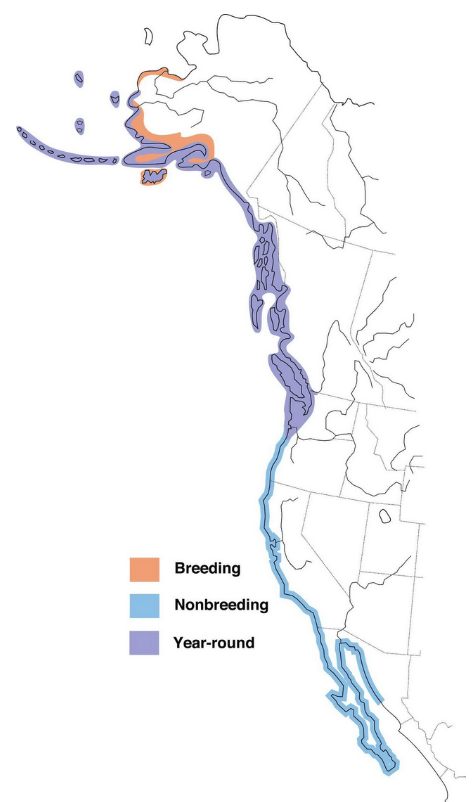
Source: https://www.allaboutbirds.org/guide/Glaucous-winged_Gull/maps-range
Bird Biology:
Characteristics: All ages have pink legs – a good field ID. From there it becomes more difficult as this gull doesn’t reach adult plumage until its fourth year. And, to add to the confusion, there are the breeding and non-breeding plumages (although not that much different). A good field bird book is needed if you want to be familiar with gulls.
Glaucous-winged Gulls are large, ranging in size from 19 -23 inches, and weighing in at around 2.0-2.5 pounds, slightly larger than a Herring Gull, but slightly smaller than a Glaucous Gull.
Adults: Look for a large, stocky gray/silver gull with gray back and gray/silver (not black) wingtips, with white spots near tip. Eyes are dark compared to light eyes on Herring and Glaucous Gulls. Their bill is yellow with some red on lower mandible and don’t forget the pink legs. Breeding birds have an all white head and neck, while non-breeding birds have mottled gray in the head and neck. They are commonly found in pairs year-round, but will forage alone or in large groups.
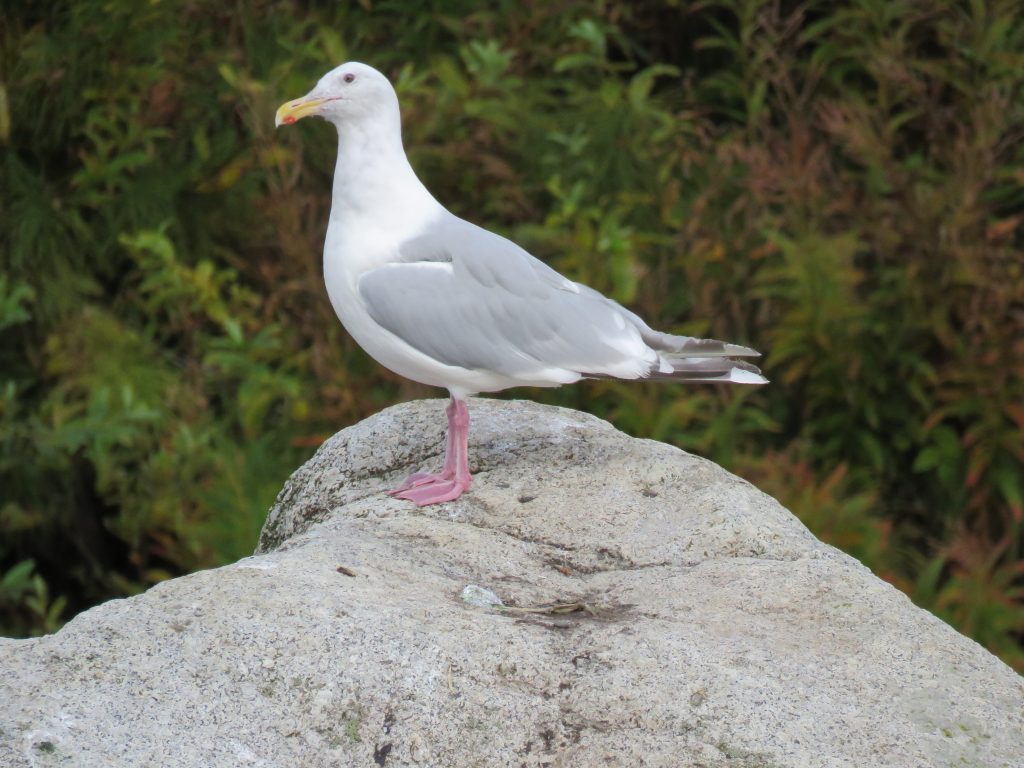
Photo by Michelle Michaud
There are a number of different plumages for birds that have yet to reach sexual maturity. For a description of the different plumages go to: https://www.allaboutbirds.org/guide/Glaucous-winged_Gull/id
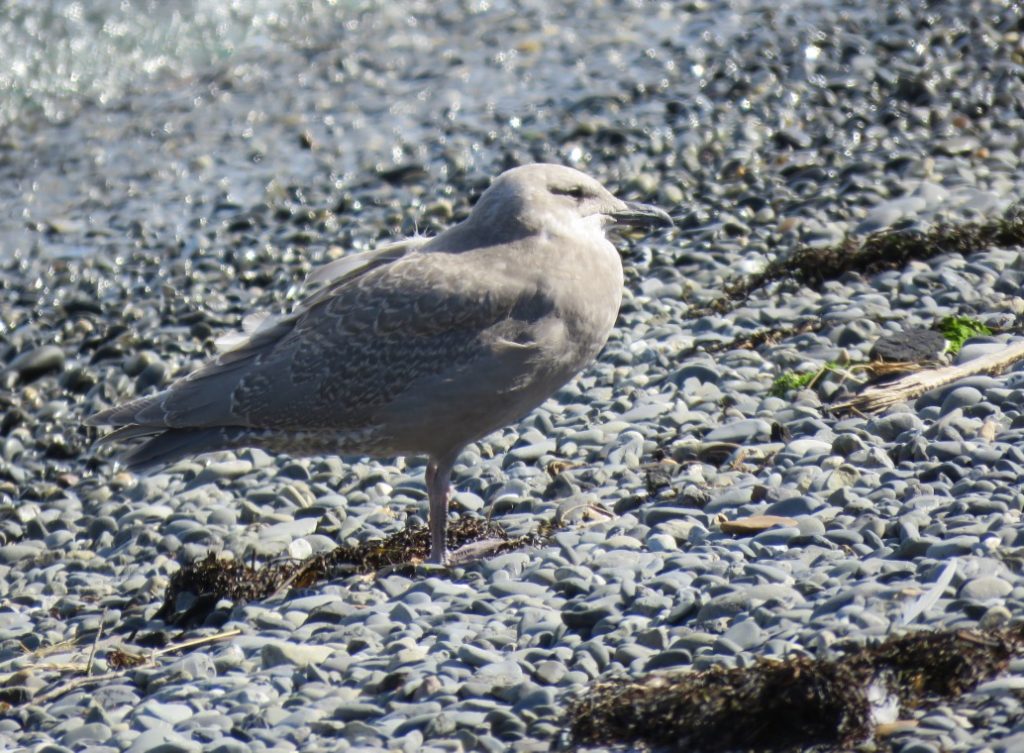
Photo by MIchelle Michaud
Preferred Habitat: Look for the Glaucous-winged Gull near or on coastal water year-round. It prefers good food sources such as bays, inlets, estuaries, beaches, harbors, mud flats, and spends much of the winter loafing on offshore waters and beaches.
In the breeding season, this gull nests on steep coastal cliffs and rocky offshore islands (e.g., Gull Island).
Breeding Season: Begins mid-May to early June, ending in August. Glaucous-winged Gulls do not begin breeding until their fourth year or later and breeds/nests in colonies, sometimes quite dense. As a social breeder, it may breed/nest in colonies with other gull species or seabirds (e.g., puffins, murres).
Nesting: Preference for a nest site is a nest on the ground, rock ledges, and cliffs, but they may nest on suitable buildings or structures. The pair will ‘nest bond’, generally starting several nests, but completing only one nest.
The nest is a bulky cup shape consisting of grasses, seaweed, feathers, fish bones, and other debris (including plastic, unfortunately). The use of plastic by birds is not a good use of “recycling plastic”since the plastic often be ingested or will entangle the nesting bird or chicks.
Eggs and Incubation: Typically 2-3 eggs are incubated by both parents for 26-29 days. Hatchlings are semi-precocial (eyes and ears open, but cannot move about) and downy. The chicks are fed by both parents. The chick’s coloring is cryptic to help camouflage it from predators, including other Glaucous-winged Gulls.
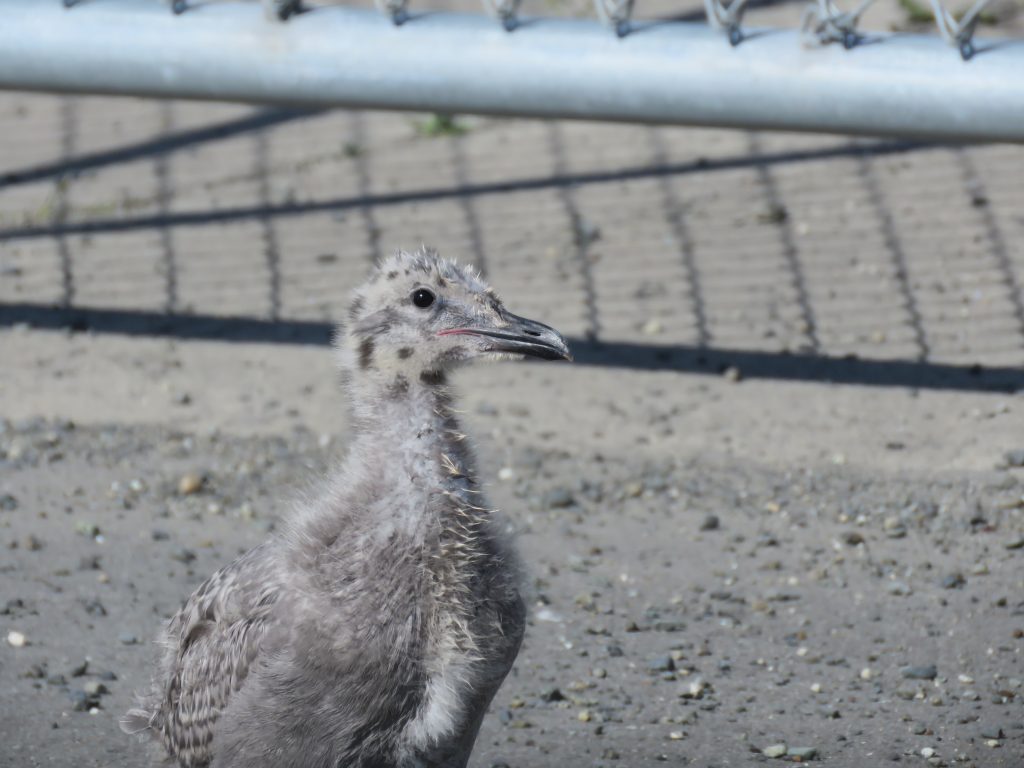
Photo by Michelle Michaud
Fledging: The chicks generally fledge 35-54 days following hatching and will leave the colony about two weeks later to forage on their own.
Food Preferences: Their primary food source is marine invertebrates (limpets, chitons, clams, mussels, squid, crab etc.) and fishes. They will also predate seabird eggs and chicks. They scavenge carrion and will eat food found in landfills and parking lots. Unfortunately people feed gulls, which attracts a lot of gulls in a feeding frenzy. The gulls create a riot as they swoop in to grab the morsel. This human activity is not appropriate and illegal within the City of Homer. Gulls have a notorious reputation of hanging out, in large numbers and in mixed flocks, at landfills seeking food so many birders check out landfills to see if there are any rare gulls present.
Feeding Methodology: These gulls forage at sea, in intertidal areas, along beaches, in parking lots and landfills. When on land they are ground foragers. They take prey from the surface of water or may perform a dramatic plunge into water from the air. They will try to harass and steal food from other birds, such as cormorants.
Roosting: They a social roosters with beaches a favorite roosting spot but they can also be found roosting on pilings, guardrails, lamp posts, parking lots, and in fields or dumps

Photo by Michelle Michaud
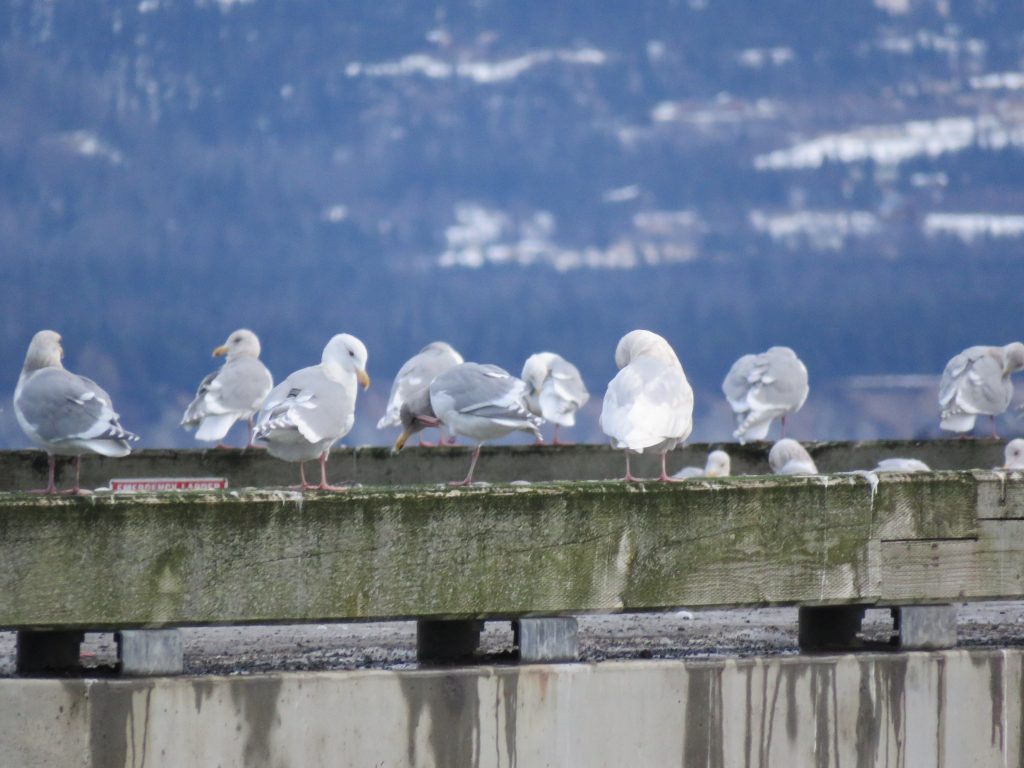
Photo by Michelle Michaud
Migration: Not all Glaucous-winged Gulls migrate as many northern birds are year-round residents, moving with the food resources. For those that do migrate, spring migration is from late February to early May. Fall migration is from late August to late November. They may migrate as far south as northwestern Mexico but are rarely found inland, preferring a coastal environment.
Vocalizations: This bird’s call is a “keow” whistle. If an intruder approaches you will here the ‘ga, ga’ notes. I think that is one we’ve all heard and is most familiar.
Threats: Fishing line and hooks are deadly as Glaucous-winged Gulls are opportunistic scavengers and can ingest a hook or get entangled. So if you see fishing line and hooks on the ground, pick them up and dispose of them properly. And if you are out fishing, do not discard these items onto the ground or from your fishing boat.
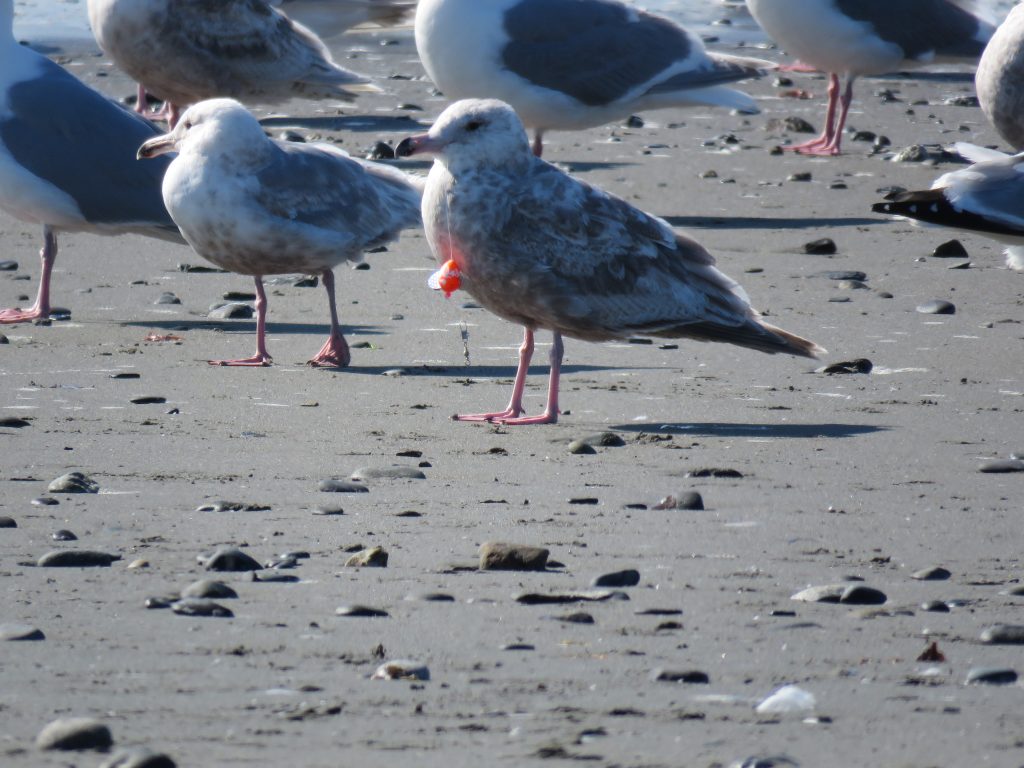
Photo by Michelle Michaud
Fun Facts:
- This bird hybridizes with the Herring Gull, Western Gull, and Glaucous Gull. The young may possess physical characteristics of both parents.
- Gulls are often difficult enough to identify, especially before they reach sexual maturity, but added to that is the fact that they often inter-breed and hybridization makes field identification more difficult. Pete Dunne recommends that if you find a gull with “… a mixed array of traits, consider the very possibility that it’s a hybrid” and either try to tease out what the bird is or move on to another gull.
- This is the one of five North American Gulls that does not have black on its wing-tips.
Conservation Status:
Audubon Alaska has identified the Glaucous-winged Gull species as a common species that is declining or vulnerable, thereby warranting species conservation attention. It is estimated that 44% of the bird’s population resides in Alaska making it at-risk for climate change and other environmental influences.
The International Union for Conservation of Nature and Natural Resources (IUCN) has identified the population of the Glaucous-winged Gull as increasing, with no genuine threats to the global population estimated at over 570,000 individuals.
Similar Species in Alaska: Glaucous Gull, Herring Gull
Sources of Information:
All About Birds. Cornell Lab of Ornithology. Downloaded on January 10, 2019 at https://www.allaboutbirds.org/guide/Glaucous-winged_Gull/id
Baicich, Paul J. and Harrison, Colin J.O. 1997. Nests, Eggs, and Nestlings of North American Birds, 2nd Edition. Princeton Field Guides.
BirdLife International 2018. Larus glaucescens. The IUCN Red List of Threatened Species 2018: e.T22694334A132543276. http://dx.doi.org/10.2305/IUCN.UK.2018-2.RLTS.T22694334A132543276.en. Downloaded on 10 January 2019.
Dunne, Pete. 2006. Pete Dunne’s Essential Field Guide Companion: Comprehensive Resource for Identifying North American Birds. Houghton Mifflin Company.
Lucas DeCicco/McCaulay Library/Cornell University Ornithology Lab (ML174609).
National Audubon Society. Audubon: Guide to North America Birds. Downloaded on January 10, 2019 at: https://www.audubon.org/field-guide/bird/glaucous-winged-gull
Todd, Frank S. 1994. 10,001 Titillating Tidbits of Avian Trivia. Ibis Publishing Company.
Warnock, N. 2017. The Alaska WatchList 2017. Audubon Alaska, Anchorage, AK 99501. Downloaded on January 10, 2019 at: http://ak.audubon.org/sites/g/files/amh551/f/annotated_watchlist_common_decline_2017.pdf
The gallery was not found!